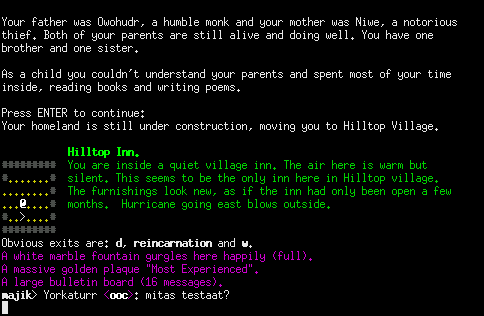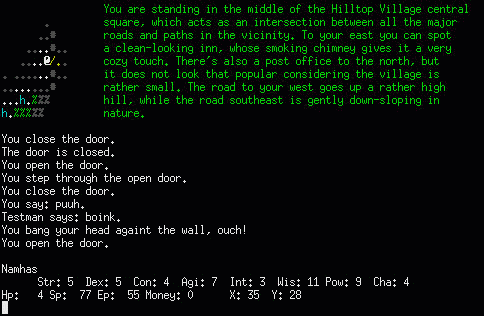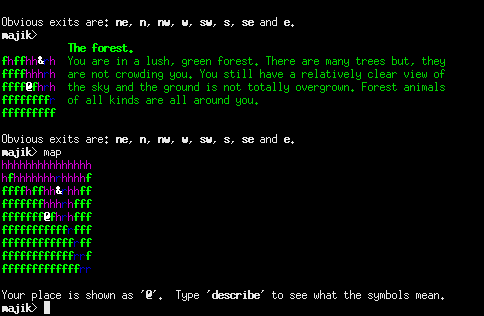Future directions
The Majik game to create today
In spite of the fact that many other ex-Majik developers would not agree,
the original developer-founder of the project would continue along the lines
of Torrac (also see history), which means discarding
3D and going back to text-based MUD (Multi User Dungeon). This was already
discussed in 2002 in a forum thread.
The reason for this is simple: consider
a book, and a movie. In the former the mind's eye creates the graphics,
while in the latter the graphics are made by others and it is always the
same. The experience is
external, while when reading a book the relationship with the book becomes more
intimate as the mind is working with the book in creating the immersive
experience. With a book, the "graphics" are living, even though the text would be the
same: each time a reader reads a line of text, different imaginations may
be experienced.
Flexibility for personal interpretation could be improved
in a graphics game by using low-resolution or blocky graphics
that leave headroom for imagination (e.g. as is in Minecraft or Roblox),
or even by using pseudographics made up from ASCII characters,
such as using the @-character for
representing the player as was in Nethack-like text-based roguelike games,
or as we used in Majik 4 or in Majik 3 room visualization, but it is still
a @ that we see and it is really
hard not to see the @ as the @ as it is. Instead of moving a @, a blocky character or even
a beautiful premade high resolution character on the screen, it feels more
personal and believable if we say "You walk to a forest". That is
symbolic representation versus guided visualization meditation. After all,
this is how tabletop roleplaying games used to work. It requires some effort
from the players because book reading or mudding is not a passive sport, but
it is worth the effort. As a bonus, plain text works everywhere, even on
1970s hardware, and for most, blind users included.
Creating the ultimate immersion

For creating a new MUD decades after the golden days of mudding, in an age
where it is rare for anyone to even read books, the MUD needs to have
something special to warrant its existence. One reason for creating a new MUD
today would be to experiment with taking the absolutely best advantage of
what the format offers.
The reason why the genre is almost forgotten might be the fact many of the MUDs
were created in a time where it was not technically or economically
feasible to do anything else, so the games essentially were just placeholders
for something better to come later. They were not created for taking
advantage of the lack of graphics, but they were created apologizing for
the lack of graphics. We see two very common unfortunately developments:
- many MUD started adding Nethack-like pseudographics made up from ASCII
characters for representing the environment;
- as it was not strictly necessary to read the textual descriptions
as there was pseudographical visualizations, maps, "obvious exists"-lines
and other convenience features,
the textual descriptions of the surrounding environment were not actually
read, only written because a policy in many MUDs mandated them to be
written and the same policy often set a minimum number of lines, making
most of the descriptions wasteful and repetitive, further discouraging
people from reading the text, encouraging them to use the brief-mode
convenience feature.
For taking advantage of the lack of graphics for the ultimate immersion through
imagination, there does not need to be surplus
of text, but optimal amount of text. Surprisingly the optimal amount of
text is often much less than was common in past MUDs, but the text
should be more varied. Less to read encourages reading, and as it is
less repetitive, people read it more. The text can be made to be much
shorter and more varied by not writing less text, but writing the text
from a range of point of views. For example, when choosing to walk
north on a forest path, the player could read:
You walk the forest path
and arrive to a clearing made for an old water well. Past the clearing,
the path continues north.
That is, a descriptive text would be written not only once for a location,
but many times in different form depending on the point of view, but there
would be less text for each viewpoint, for example there is not need to
describe the direction from where the player came from. More descriptions
could be given
on demand, for example the player could "look at well" for getting a fuller
picture, but it is not necessary to get these details every time when walking
around.
In comparison, common for past MUDs was to have a description either
like this:
Forest clearing.
You are standing in a forest clearing. There is an old water well in
the middle of the clearing. It is made out of stone and wood. There could
be water in it. Around the clearing, there is a forest path that goes south
towards a small village and there is a path in the north that goes
further to the forest. Light clouds move in weak storm going southwest.
Obvious exits are: north, south.
Or using a brief-mode convenience feature, giving a text
similar to:
Forest clearing (n,s).
The past MUDs either printed a full description, which was too much for anyone
to read repeatedly, or they gave too little. Both of these cases
led people to forget they are actually walking on a forest path, walking
up or down a hill or walking away or towards something. The
same reasons eventually made Majik go fully 3D, for giving these sensations.
But this is not necessary, if optimal amount of text is shown,
with optimal pace and lack of repetition, encouraging people to
read the text and get the sensations through imagination. There
then the players can experience a
three dimensional world in their heads and it can be a
fuller 3D experience than what a high resolution 3D game could ever give,
just like reading a book is regarded by many as being the definite way
to experience a story while a movie made out of a story being
just a cheap way for the lazy people who will miss a lot in the end.
About tactical battle

Another reason why we started going to 2D and 3D graphics or
pseudographics was that we wanted to add tactical depth to battles, namely
for being able to take line of sight into account for increasing
tactical depth in ranged combat and for making various ambushing
and hit & run tactics possible, but what the 2D and 3D interfaces
actually give is an ability to micromanage positions turning the
roleplaying game into a game of chess, or into a realtime strategy
game (RTS), sometimes even into an action game.
Rather than micromanaging these things, if the intention
of the player is to ambush someone, an ambush skill could
be used, skill check rolled based on the difficulty given by the
environment, light levels and various factors, and then either the
ambush is successful or not, giving advantage for first strike.
Similarly for the other things, all things can be simulated in text
and micromanagement and RTS-like game mechanisms can be avoided
by making the game and the battles intention-driven, keeping it a
roleplaying game and letting the imaginations of the players to fill
in the details of what an ambush in a forest would look and feel
like.
Behind the scenes the game engine can keep track of positions
on a detailed level, but giving out that information, or letting
the players micromanage the details is not worth endangering the immersion,
as it would risk jumping into the rabbit hole
of how to visualize these details. Rather we can simply write:
"A thief approaches you from behind and stabs with a knife.".
Obviously such a deed would not be possible if the thief cannot
physically get behind your character without your character noticing
it first. Players can choose positions by stating intentions, e.g.
one player can choose to follow behind another player's character,
thereby protecting the other's back.
About distances

In an ordinary MUD with an outworld map characters could travel vast
distances in minutes by repeatedly typing the same command over and
over again. It is not possible to make it any slower other than by
using an endurance points system that would demand the player character
to rest every now and then. That is, distances are simulated by
burdensome hacking of the same keys over and over again, making the
player exhausted. In a 3D game travelling over distances can be more
enjoyable as there is actual scenery to experience along the way, but
yet the burden is actually on the player, not on the player character,
making it more like an action game rather than a roleplaying game.
In a text-based game that is striving for taking advantage of the lack of graphics,
rather than by implementing pseudographical outworld as was common in past
MUDs, the free exploration outworld map could be regarded as wasteful
micromanagement of location, as there in the outworld there really is not
anything that interesting between the actual areas of interest. The
wasteful repetition of commands can be replaced by intention-based
commands and mechanisms.
For example, if the player wants to go to an
another city that is far away, the player could find a caravan or a
ship that is going that way, and that would be possible only once in a
while.
The time it takes to go there does not matter: the feeling of
distance is simulated by the fact that it is not possible to get back
to the original city in a snap. The time for getting there does not matter as
in a medieval fantasy setting there is no way for instant communication over
distances and timezones can be implemented for making it night
at the destination if it was day at the place of departure. The player
character which goes travelling, practically disappears from the midst
of the others who did not travel.
There's
plenty for the explorers to explore if there is anything to explore
in the first place. A huge, but empty outworld map is a poor substitute,
yet such is often used in MUDs for satisfying
the explorers. This solves the problem of
travelling vast distances too fast
and solves the problem of rapidly repeating movement commands, all without
needing pseudographics or without significantly decreasing exploration
possibilities.
About activities that depend on vast areas
One could also ask what to do with activities like hunting, mineral mining,
fishing, herbalism and others which traditionally depend on an open outworld
of considerable size, or on areas with a lot of locations which look all
the same, e.g. forests that allow free movement within the forest. These
activities can work without repetitive wandering in areas that look all
the same because it can also be done in an intention-driven manner.
Specifically
the player can type "hunt" to start a hunting procedure in an area that
is suitable for hunting, which then uses relevant skills such as animal
tracking for finding game, and then takes the player character to
an automatically created location of a particular type that can be used for
the part where arrows are shot and the game is killed, skinned and
processed, or from where the player character flees away in panic. The
others see that the player character "goes hunting", and at some point
"returns from hunting". Naturally others can follow and it can be possible
to meet others in the hunting grounds. Keeping it driven
by intention, the game does not turn into an action game or RTS, like
often happens in MMORPGs and traditional MUDs.
The desire for finding
better locations for these activities is satisfied by the fact that the places
from where the activity is started can be different, even dynamically
based on the number of times people have been doing the particular
activity there, yielding
better or worse results.
Making it compatible with today
The original MUDs were made for devices of past. Even though they still work
fine, if a new MUD would be written today, it would make sense to optimize
it for the way how people use their devices today. A new MUD can be optimized
for using it from a Web browser and a new MUD can be optimized for tablet and
phone usage as well as for playing with a mouse.
For example, moving to a direction can happen by clicking or tapping on a
highlighted direction in the description instead of typing "west" or "w",
even though typing would still be possible. In a similar way, looking at
items is possible. Action buttons can be implemented for changing the default
action i.e. whether clicking or tapping triggers a look-action, or a
get-action, or whatever.
For phone usage, these convenience features are a must-have, and similarly
it is a requirement to no longer use pre-wrapped 80-column lines as in the
past MUDs, but we need to let the text be auto-wrapped according to the
phone's screen width.
Where to get content?
The legacy Majik 3D MMORPG's world was quite well designed and there's
plenty of interesting content, like maps and area descriptions, that can
be used as a base.
If you wish to help...



